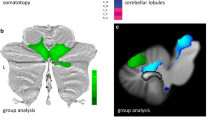Abstract
Introduction
Yet unreported in this lysosomal storage disease, we aimed to quantify our observation that patients with fucosidosis may show abnormally increased cerebellar volumes during early childhood.
Methods
Five normocephalic fucosidosis patients (age range 2–25 months, three males) were included in this retrospective case control study. The control cohort consisted of 25 children (age range 0–36 months, 15 males). Image postprocessing was performed independently by two radiologists. Using validated software, manual tracing of contours on contiguous sagittal magnetic resonance images was allowed for cerebellar volumetry. We tested the null hypothesis that mean cerebellar volumes of four fucosidosis patients (age 16, 20, 21, and 25 months) and of an age-matched control cohort (n = 8, age range 13–26 months) were equal based on a two-tailed unpaired t-test.
Results
Interobserver agreement was excellent (R = 1, p < 0.01). A rough trajectory of normal cerebellar development appeared to flatten around the age of 1 year. With mean volumes of 121.36 and 102.30 ml, respectively, cerebellar volumes of fucosidosis patients with a mean age of 21 months were significantly increased compared to age-matched controls (p < 0.05). In a single patient, longer-term follow-up with MRI at the age of 47 months was available and showed cerebellar atrophy.
Conclusion
Increased cerebellar volume was shown to be an additional feature in the early stage of fucosidosis. The combination with a confirmed tendency toward atrophy of the cerebellum during later course of the disease is probably unique in the context of metabolic disorders of the brain.




Similar content being viewed by others
References
Pinsky L, Callahan JW, Wolfe LS (1968) Fucosidosis? Lancet 2:1080
Durand P, Borrone C, Della Cella G (1969) Fucosidosis. J Pediatr 75:665–674
Willems PJ, Seo HC, Coucke P, Tonlorenzi R, O’Brien JS (1999) Spectrum of mutations in fucosidosis. Eur J Hum Genet 7:60–67
Willems PJ, Gatti R, Darby JK, Romeo G, Durand P, Dumon JE, O’Brien JS (1991) Fucosidosisrevisited: a review of 77 patients. Am J Med Genet 38:111–131
Inui K, Akagi M, Nishigaki T, Muramatsu T, Tsukamoto H, Okada S (2000) A case of chronic infantile type of fucosidosis: clinical and magnetic resonance image findings. Brain Dev 22:47–49
Krivit W, Peters C, Shapiro EG (1999) Bone marrow transplantation as effective treatment of central nervous system disease in globoid cell leukodystrophy, metachromatic leukodystrophy, adrenoleukodystrophy, mannosidosis, fucosidosis, aspartylglucosaminuria, Hurler, Maroteaux-Lamy, and Sly syndromes, and Gaucher disease type III. Curr Opin Neurol 12:167–176
Provenzale JM, Barboriak DP, Sims K (1995) Neuroradiologic findings in fucosidosis, a rare lysosomal storage disease. AJNR Am J Neuroradiol 16:809–813
Galluzzi P, Rufa A, Balestri P, Cerase A, Federico A (2001) MR brain imaging of fucosidosis type I. AJNR Am J Neuroradiol 22:777–780
Barkovich J (2005) Pediatric neuroimaging, 4th edn. Lippincott Williams &Wilkins, Philadelphia, pp 160–161
Mamourian AC, Hopkin JR, Chawla S, Poptani H (2010) Characteristic MR spectroscopy in fucosidosis: in vitro investigation. Pediatr Radiol 40:1446–1449
Oner AY, Cansu A, Akpek S, Serdaroglu A (2007) Fucosidosis: MRI and MRS findings. Pediatr Radiol 37:1050–1052
Prietsch V, Arnold S, Kraegeloh-Mann I, Kuehr J, Santer R (2008) Severe hypomyelination as the leading neuroradiological sign in a patient with fucosidosis. Neuropediatrics 39:51–54
Iwasaki N, Hamano K, Okada Y, Horigome Y, Nakayama J, Takeya T, Takita H, Nose T (1997) Volumetric quantification of brain development using MRI. Neuroradiology 39:841–846
Buechel EV, Kaiser T, Jackson C, Schmitz A, Kellenberger CJ (2009) Normal right- and left ventricular volumes and myocardial mass in children measured by steady state free precession cardiovascular magnetic resonance. J Cardiovasc Magn Reson 11:19
Kondagari GS, Yang J, Taylor RM (2011) Investigation of cerebrocortical and cerebellar pathology in canine fucosidosis and comparison to aged brain. Neurobiol Dis 41:605–613
Steenweg ME, Vanderver A, Blaser S, Bizzi A, de Koning TJ, Mancini GM, van Wieringen WN, Barkhof F, Wolf NI, van der Knaap MS (2010) Magnetic resonance imaging pattern recognition in hypomyelinating disorders. Brain 133:2971–2982
Autti T, Joensuu R, Aberg L (2007) Decreased T2 signal in the thalami may be a sign of lysosomal storage disease. Neuroradiology 49:571–578
Knickmeyer RC, Gouttard S, Kang C, Evans D, Wilber K, Smith JK, Hamer RM, Lin W, Gerig G, Gilmore JH (2008) A structural MRI study of human brain development from birth to 2 years. J Neurosci 28:12176–12182
Lenroot RK, Gogtay N, Greenstein DK, Wells EM, Wallace GL, Clasen LS, Blumenthal JD, Lerch J, Zijdenbos AP, Evans AC, Thompson PM, Giedd JN (2007) Sexual dimorphism of brain developmental trajectories during childhood and adolescence. Neuroimage 36:1065–1073
Tiemeier H, Lenroot RK, Greenstein DK, Tran L, Pierson R, Giedd JN (2010) Cerebellum development during childhood and adolescence: a longitudinal morphometric MRI study. Neuroimage 49:63–70
Ekinci N, Acer N, Akkaya A, Sankur S, Kabadayi T, Sahin B (2008) Volumetric evaluation of the relations among the cerebrum, cerebellum and brain stem in young subjects: a combination of stereology and magnetic resonance imaging. Surg Radiol Anat 30:489–494
Acknowledgments
We would like to acknowledge Prof. Dr. Philippe Maeder, Prof. Dr. Reto Meuli, Dr. Patric Hagmann, PD Dr. Luisa Bonafé, and Dr. D. Ballhausen from Centre Hospitalier Universitaire Vaudois Lausanne for kindly providing imaging and clinical data. Furthermore, we are thankful to Mrs. Hadwig Speckbacher, Mrs. Martina Studhalter, and Mrs. Leila Thalparpan-Pajunen for their technical help with this study.
Conflict of interest
We declare that we have no conflict of interest.
Author information
Authors and Affiliations
Corresponding author
Rights and permissions
About this article
Cite this article
Kau, T., Karlo, C., Güngör, T. et al. Increased cerebellar volume in the early stage of fucosidosis: a case control study. Neuroradiology 53, 509–516 (2011). https://doi.org/10.1007/s00234-011-0855-1
Received:
Accepted:
Published:
Issue Date:
DOI: https://doi.org/10.1007/s00234-011-0855-1




